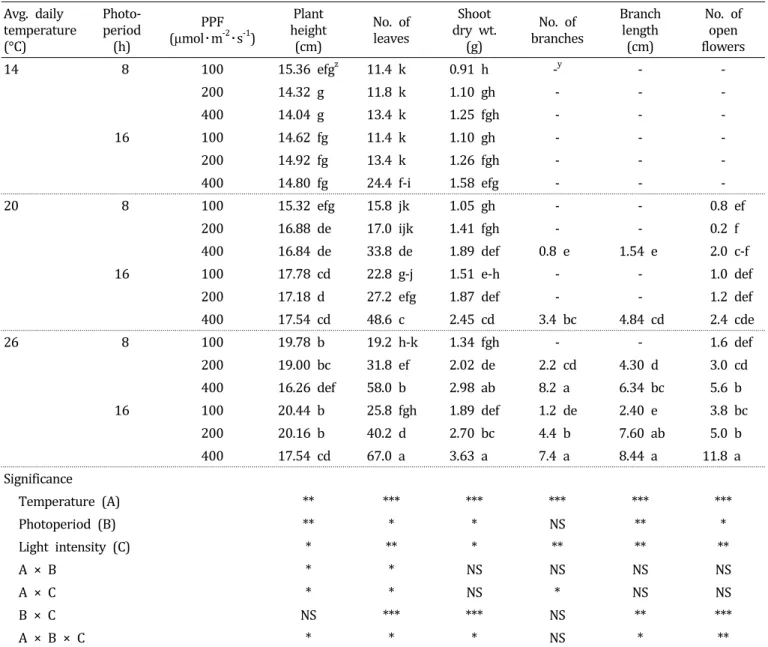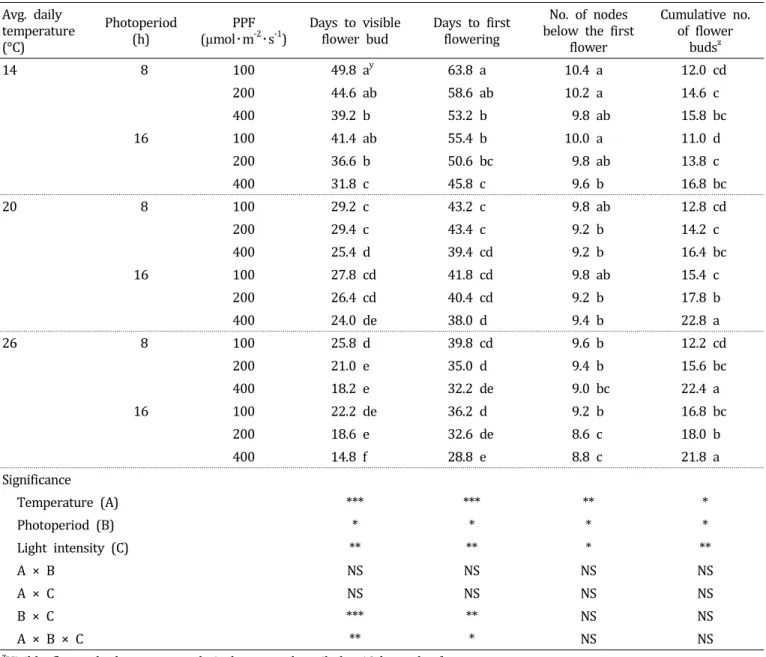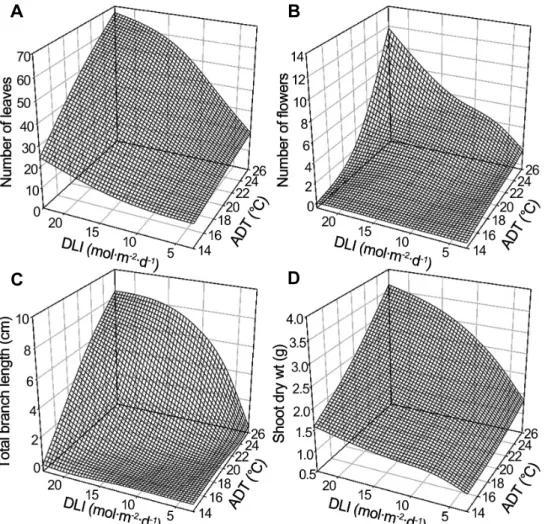Research Report
Effects of Temperature, Photoperiod and Light Intensity on Growth and Flowering in Eustoma grandiflorum
Wook Oh
*Department of Horticulture & Life Science, Yeungnam University, Gyeongsan 712-749, Korea
Abstract: Lisianthus (Eustoma grandiflorum) is relatively sensitive to temperature and light conditions. For year round production of good quality potted plants and energy saving, it is necessary to understand the growth and flowering response to the combined conditions of these environmental factors. This study was conducted to examine the growth and flowering responses to temperature, photoperiod, and light intensity during the post-seedling stage. ‘El Paso Deep Blue’ lisianthus plants with four true leaf pairs were grown in growth chambers maintained at average daily temperatures (ADT) of 14, 20, and 26°C and provided with three photosynthetic photon fluxes [PPF; 100, 200, and 400 µmol・m
-2・s
-1] for 8 (08:00-16:00) and 16 hours (08:00-24:00) by fluorescent and incandescent lamps, resulting in four daily light integrals (DLI): about 3, 6 (two photoperiods), 12 (two photoperiods), and 24 mol・m
-2・d
-1. After treatment for three weeks followed by growth for one week in a greenhouse of 20 ± 3°C, growth and development were measured. Higher temperature, higher PPF, and longer photoperiod promoted plant growth and flowering;
however the impacts of PPF and photoperiod were smaller than those of temperature. As ADT and DLI increased, the number of leaves, number of flowers, lateral shoot length, and shoot dry weight increased. An increase of about 1 mol・m
-2・d
-1DLI could constitute an increase of 0.40 to 0.76°C ADT depending on these crop characteristics when ADT and DLI are above 20°C and 12 mol・m
-2・d
-1, respectively. Therefore, growers can select a regimen of heating or supplemental lighting without delaying harvesting time or decreasing crop quality.
Additional key words:
heating cost, energy saving, lisianthus, photosynthetic photon flux, supplemental lighting*Corresponding author: wookoh@ynu.ac.kr
※ Received 17 February 2015; Revised 26 February 2015; Accepted 26 February 2015. This research was supported by Yeungnam University research grants in 2012.
Ⓒ 2015 Korean Society for Horticultural Science
Introduction
Eustoma grandiflorum (Raf.) Shinn. (eustoma or lisianthus) originates in the southern part of the United States (Dole and Wilkins, 2005; Halevy and Kofranek, 1984; Kawakatsu and Fukuta, 2012). This plant initially forms a rosette after seed germination, grows very slowly during winter, elongates its stems in spring, and then flowers in summer (Dole and Wilkins, 2005; Roh et al., 1989). Eustoma is a seed- propagated ornamental plant grown as cut flowers and potted plants worldwide. Selected cultivars and environ- mentally controlled greenhouses have enabled year-round production (Islam et al., 2005).
Eustoma is generally classified as a quantitative long-day plant (LDP) (Dole and Wilkins, 2005; Grueber et al., 1984;
Roh et al., 1989; Thomas and Vince-Prue, 1997; Tsukada et al., 1982; Zaccai and Edri, 2002), but some researchers (Azrak, 1984; Halevy and Kofranek, 1984; Harbaugh, 1995;
Islam et al., 2005) consider a number of cultivars to be day- neutral or obligate LD plants due to their complex responses to photoperiod. Harbaugh et al. (1997) reported that photoperiodic response of Eustoma was cultivar-dependent as most cultivars are facultative LDPs, but a few are almost day-neutral or obligate LD plants. Time to flowering of eustoma has also been shown to be reduced by high light intensity (Corr and Katz, 1997; Islam et al., 2005) and high temperature (Islam et al., 2005; Zaccai and Edri, 2002).
However, these previous studies have not sufficiently
explained the independent or interactive effects of tem-
perature, photoperiod, and light intensity because they used two parameters with two levels. In addition, the effects of these environmental conditions on growth and flowering of eustoma are affected by developmental stage (Zaccai and Edri, 2002). At the seedling stage (up to 4-5 true leaf pairs), higher temperatures induce rosette formation and delay bolting (Ohkawa et al., 1994) depending on cultivars (Harbaugh and Scott, 1999). At the later stage, stem elongation and flower bud initiation and development can be hastened by higher temperature, higher light intensity, and long days (LD) (Halevy and Kofranek, 1984; Harbaugh, 1995; Roh and Lawson, 1984).
For year round production of good-quality eustoma, it is necessary to understand the growth and flowering responses to combined conditions of three environmental factors including temperature, photoperiod, and light intensity.
Therefore, this study was conducted to examine the effects of temperature, photoperiod, and light intensity during the post-seedling stage on growth and flowering in E. grandiflorum.
Materials & Methods
Plant materials and growing conditions
E. grandiflorum ‘El Paso Deep Blue’ seedlings were received from a commercial propagator (ACC KA Seed & Seedling Co., Ltd., Jincheon, Korea), transplanted to plastic pots (7 cm diameter) filled with Sunshine Mix #1 (Sun-Gro Horti- culture, Bellevue, WA, USA) on April 10, and grown in a greenhouse at 22 ± 2°C until the beginning of treatments.
The potted plants were watered using a stagnant wick subirrigation system with nutrient solutions of 150 mg・L
-1N from 20N-3.7P-16.6K (Technigro 20-9-20 Plus, Sun-Gro Horticulture) and 15N-0P-12.5K fertilizer (Technigro 15-0-15 Plus, Sun-Gro Horticulture) in alternation.
Temperature and light treatments
Plants with six expanded leaves were moved to growth modules in walk-in chambers. Three environmentally controlled chambers were maintained at 14 ± 2°C (LT), 20 ± 2°C (MT), and 26 ± 2°C (HT), respectively. Each chamber was divided into two sections that generated 8 h (short day, SD, 08:00-16:00) and 16 h (long day, LD, 08:00-24:00) photoperiods using fluorescent lamps (FL; FL20SEX-D, Kumho Electric Inc., Seoul, Korea) and incandescent lamps (INC; IL220V30W-L, Kumho Electric Inc., Seoul, Korea).
Three modules in each section provided three photosynthetic photon fluxes [PPF, 100 ± 5 (LL), 200 ± 10 (ML), and 400 ± 20 (HL) µmol・m
-2・s
-1] at canopy height. The FL:INC
ratio in PPFD at the plant canopy was about 8:2; therefore, plants were exposed to four levels of daily light integral [DLI, DLI (mol・m
-2・d
-1) = PPF (µmol・m
-2・s
-1) × photoperiod (h・d
-1) × 60 (min・h
-1) × 60 (s・min
-1) × 10
-6], about 3 (LL
× SD), 6 (LL × LD and ML × SD), 12 (ML × LD and HL
× SD), and 24 (HL × LD) mol・m
-2・d
-1. Twenty plants were grown in each module under different light and temperature conditions (total 18 treatments) for 3 weeks.
Data collection and analysis
Morphological characteristics such as plant height, numbers of nodes and branches, visible flower buds, open flowers and shoot dry weight (DW) were evaluated at six weeks after the start of treatments based on ten plants per treat- ment. Leaf canopy height was measured from the surface of the growth medium to the top of the shoot and DW was measured after drying shoots for three days at 80°C.
The remaining ten plants were grown continuously until the 10th week after treatment and the date of VB (when the first flower bud was 2 mm in size) and flowering, numbers of nodes below the first flower bud and cumulative flower buds were recorded.
Data were analyzed by SAS (SAS Institute Inc., Cary, NC, USA) using analysis of variance (ANOVA) and the general linear model (GLM) procedures. Regression analysis was conducted using SigmaPlot (SigmaPlot v10, Systat Software Inc., Chicago, IL, USA). A p < 0.05 was considered to indicate significance.
Results and Discussion Plant growth and flowering
Temperature (ADT), photoperiod, and light intensity solely
and interactively influenced the growth characteristics of
E. grandiflorum ‘El Paso Deep Blue’ (Table 1). After tem-
perature and light treatments for three weeks and subsequent
growth for three weeks in a greenhouse, plant height
increased as ADT increased from 14°C to 26°C. Light
conditions had a smaller impact on plant height than
temperature in this study. However, LD promoted stem
elongation relative to SD under MT+LL, and HT+HL inhibited
stem elongation regardless of photoperiod. High temperature,
long photoperiod, and low PPFD promote the biosynthesis
of active gibberellic acids such as GA
1and GA
4in cyclamen
(Oh, 2007). Additionally, longer photoperiod induced transiently
elevated levels of GAs (Olsen et al., 1997). Silene armeria
under LD had higher levels of GA
1, whereas the content
was lower under SD (Talon and Zeevaart, 1990). Stem
Table 1. Growth and flowering characteristics at 6 weeks after treatment as influenced by temperature, light intensity and photoperiod for 3 weeks in Eustoma grandiflorum ‘El Paso Deep Blue’.
Avg. daily temperature (°C)
Photo- period (h)
(µmol・m PPF
-2・s
-1)
Plant height (cm)
No. of leaves
Shoot dry wt.
(g)
No. of branches
Branch length
(cm)
No. of open flowers
14 8 100 15.36 efg
z11.4 k 0.91 h -
y- -
200 14.32 g 11.8 k 1.10 gh - - -
400 14.04 g 13.4 k 1.25 fgh - - -
16 100 14.62 fg 11.4 k 1.10 gh - - -
200 14.92 fg 13.4 k 1.26 fgh - - -
400 14.80 fg 24.4 f-i 1.58 efg - - -
20 8 100 15.32 efg 15.8 jk 1.05 gh - - 0.8 ef
200 16.88 de 17.0 ijk 1.41 fgh - - 0.2 f
400 16.84 de 33.8 de 1.89 def 0.8 e 1.54 e 2.0 c-f
16 100 17.78 cd 22.8 g-j 1.51 e-h - - 1.0 def
200 17.18 d 27.2 efg 1.87 def - - 1.2 def
400 17.54 cd 48.6 c 2.45 cd 3.4 bc 4.84 cd 2.4 cde
26 8 100 19.78 b 19.2 h-k 1.34 fgh - - 1.6 def
200 19.00 bc 31.8 ef 2.02 de 2.2 cd 4.30 d 3.0 cd
400 16.26 def 58.0 b 2.98 ab 8.2 a 6.34 bc 5.6 b
16 100 20.44 b 25.8 fgh 1.89 def 1.2 de 2.40 e 3.8 bc
200 20.16 b 40.2 d 2.70 bc 4.4 b 7.60 ab 5.0 b
400 17.54 cd 67.0 a 3.63 a 7.4 a 8.44 a 11.8 a
Significance
Temperature (A) ** *** *** *** *** ***
Photoperiod (B) ** * * NS ** *
Light intensity (C) * ** * ** ** **
A × B * * NS NS NS NS
A × C * * NS * NS NS
B × C NS *** *** NS ** ***
A × B × C * * * NS * **
z
Mean separation within columns by Duncan’s multiple range test at p = 0.05.
y
No branch or flower bud was observed.
NS,*,**,***
Nonsignificant or significant at p = 0.05, 0.01, or 0.001, respectively.
elongation of spinach, a long day plant (LDP), under LD (16 h) was inhibited by theobroxide owing to decreased endogenous GA
1(Kong et al., 2006). Thus, elongated stems of eustoma plants grown under high temperature, long photoperiod and low PPFD in this study were assumed to result from an increase in active GAs for stem elongation.
Leaf number and shoot dry weight increased with increasing temperature, photoperiod, and light intensity (Table 1). Moreover, the promoting effects of PPFD on
dry mass accumulation became greater as temperature
increased from 14°C to 26°C because the difference in
dry weight among LL, ML and HL grew with increasing
temperature. Conversely, temperature had little effect on
the increase in dry weight in response to LD because there
was little difference in dry weight between SD and LD,
regardless of temperature change. Dramatic increases in
leaf number under HL resulted from branching and unfolding
of small leaves on lateral shoots. Temperature and light
Table 2. Parameters of regression analysis relating number of leaves and flowers, total branch length, and shoot dry weight for Eustoma grandiflorum ‘El Paso Deep Blue’ to average daily temperature [ADT (°C)] and daily light integral [DLI (mol・m
-2・d
-1)].
Parameter Intercept Slope
R
2ADT DLI
No. of leaves -29.30 ± 7.56
z**2.10 ± 0.35
****1.46 ± 0.26
****0.83
No. of flowers -8.05 ± 1.78
***0.42 ± 0.08
****0.17 ± 0.06
*0.71
Total branch length (cm) -7.87 ± 1.79
***0.40 ± 0.08
***0.19 ± 0.06
**0.69
Shoot dry wt. (g) -0.88 ± 0.31
*0.10 ± 0.01
****0.06 ± 0.01
****0.86
z
Standard error.
*,**,***,****
Significant at p = 0.05, 0.01, 0.001, or 0.0001, respectively.
conditions affect photosynthetic and leaf unfolding rates in all plants (Dole and Wilkins. 2005). For example, higher irradiance promoted growth characteristics by increasing photosynthetic rate in wax begonia (Nemali and van Iersel, 2004). Additionally, Cyclamen persicum showed increased photosynthetic rate, shoot dry weight and leaf number in response to higher daily light integral (Oh et al., 2009), while higher temperature increased plant volume, leaf number and plant dry weight at flowering (Karlsson and Werner, 2001a, 2001b). In the pansy (Viola × wittrockiana Gams.) ‘Universal Violet’, increasing light integral and temperature up to an optimum of 25 ± 3°C increased dry weight, and the rate of leaf production on the main stem increased linearly with both light integral and temperature (Adams et al., 1997a). High light intensity also increased shoot dry weight and stem diameter relative to low light in E. grandiflorum ‘Echo Blue’ and ‘Fuji Deep Blue’ (Islam et al., 2005). In addition, supplemental lighting during the seedling stage increased the number of leaves in petunia and pansy (Oh et al., 2010).
The number and length of branches showed similar trends to leaf number and shoot dry weight in response to tem- perature and light conditions (Table 1). LT at 14°C under all light treatments did not induce branching, while MT under LL and ML inhibited lateral shoot growth (Table 1). All light conditions under HT induced the development of axillary buds except for SD + LL. At HT, the number and length of branches increased with photoperiod and PPFD.
Low temperatures decreased the growth and developmental rates of processes such as branching and leaf unfolding in cyclamen (Karlsson and Werner, 2001b), and low irradiance intensified apical dominance as a phenomenon of shade avoidance syndrome induced by low irradiance under light with low red to far-red ratio (Franklin and Whitelam, 2005;
Huber and Stuefer, 1997; Moe and Heins, 1990).
All flowering characteristics of E. grandiflorum were
influenced by temperature and light conditions in this study (Table 1 and 2). After treatment for three weeks followed by growth in the greenhouse for three weeks, the number of flowers increased with increasing temperature, photoperiod, and PPFD; however, the eustoma plant had no flower under LT (Table 1). Days to visible bud and first flowering decreased with increasing temperature, photoperiod, and light intensity (Table 2). The number of nodes under the first flower was slightly reduced by higher temperature, longer photoperiod, and higher PPFD. The number of open flowers and visible buds counted until 10 weeks after treatment increased somewhat with increasing temperature, photoperiod and PPFD. Plants grown in the MT and HT chambers had more flower buds than those grown in the LT chamber, and the number of flower buds increased proportionally to PPFD. Islam et al. (2005) reported that providing a DLI of 8.8 mol・m
-2・d
-1for 16 h (LD) decreased days to visible budding and flowering compared with that of 4.4 mol・m
-2・d
-1DLI for 16 h in E. grandiflorum ‘Echo Blue’ and ‘Fuji Deep Blue’. In locations with lower light intensities, LD will enhance bolting, and high intensity discharge (HID) lighting such as high pressure sodium lamps will improve plant quality (Dole and Wilkins, 2005).
Temperature, photoperiod, and light intensity generally affect flowering of plants. Flowering is promoted by higher temperatures in cyclamen (Karlsson and Werner, 2001a, 2001b; Oh et al., 2013) and pansy (Adams et al., 1997b).
High PPFD also hastens flowering in some floriculture crops, with facultative irradiance response (Oh et al., 2009).
Photoperiod affects flowering of photoperiod-sensitive plants such as LDPs and SDPs. Flowering of E. grandiflorum generally occurred quicker or days to flowering decreased under LDs (Islam et al., 2005; Zaccai and Edri, 2002).
However, the influence of photoperiod on days to flowering
was relatively small compared with temperature and light
intensity in this study. This was likely because the effect
Table 3. Flowering characteristics at first flowering as influenced by temperature, light intensity and photoperiod for 3 weeks in Eustoma grandiflorum ‘El Paso Deep B lue’.
Avg. daily temperature (°C)
Photoperiod
(h) PPF
(µmol・m
-2・s
-1) Days to visible
flower bud Days to first flowering
No. of nodes below the first
flower
Cumulative no.
of flower buds
z14 8 100 49.8 a
y63.8 a 10.4 a 12.0 cd
200 44.6 ab 58.6 ab 10.2 a 14.6 c
400 39.2 b 53.2 b 9.8 ab 15.8 bc
16 100 41.4 ab 55.4 b 10.0 a 11.0 d
200 36.6 b 50.6 bc 9.8 ab 13.8 c
400 31.8 c 45.8 c 9.6 b 16.8 bc
20 8 100 29.2 c 43.2 c 9.8 ab 12.8 cd
200 29.4 c 43.4 c 9.2 b 14.2 c
400 25.4 d 39.4 cd 9.2 b 16.4 bc
16 100 27.8 cd 41.8 cd 9.8 ab 15.4 c
200 26.4 cd 40.4 cd 9.2 b 17.8 b
400 24.0 de 38.0 d 9.4 b 22.8 a
26 8 100 25.8 d 39.8 cd 9.6 b 12.2 cd
200 21.0 e 35.0 d 9.4 b 15.6 bc
400 18.2 e 32.2 de 9.0 bc 22.4 a
16 100 22.2 de 36.2 d 9.2 b 16.8 bc
200 18.6 e 32.6 de 8.6 c 18.0 b
400 14.8 f 28.8 e 8.8 c 21.8 a
Significance
Temperature (A) *** *** ** *
Photoperiod (B) * * * *
Light intensity (C) ** ** * **
A × B NS NS NS NS
A × C NS NS NS NS
B × C *** ** NS NS
A × B × C ** * NS NS
z
Visible flower buds were cumulatively counted until the 10th week after treatment.
y
Mean separation within columns by Duncan’s multiple range test at p = 0.05.
NS,*,**,***

![Table 2. Parameters of regression analysis relating number of leaves and flowers, total branch length, and shoot dry weight for Eustoma grandiflorum ‘El Paso Deep Blue’ to average daily temperature [ADT (°C)] and daily lig](https://thumb-ap.123doks.com/thumbv2/123dokinfo/5464540.438571/4.892.68.830.908.1047/parameters-regression-analysis-relating-flowers-eustoma-grandiflorum-temperature.webp)

